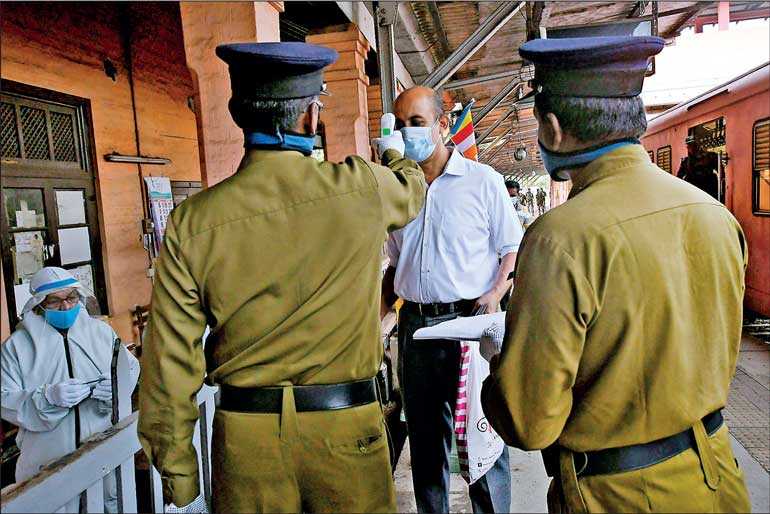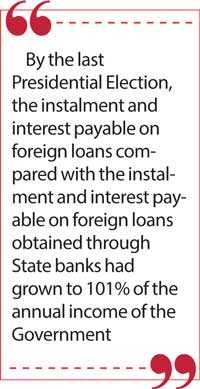Sunday Dec 22, 2024
Sunday Dec 22, 2024
Friday, 29 May 2020 00:00 - - {{hitsCtrl.values.hits}}

Sri Lanka is now going through the last stage of the disastrous, multi-phased journey into the rock bottom of a great abyss, which had begun 72 years ago and gradually progressed in several phases.  The time cohorts from 1948 to 1956, 1956 to 1978, 1978 to 2009 and 2009 to 2020 can be considered its main phases. In each phase the volume of the crisis remained much greater than it was in the immediately preceding phase and it can be considered a salient feature of this journey.
The time cohorts from 1948 to 1956, 1956 to 1978, 1978 to 2009 and 2009 to 2020 can be considered its main phases. In each phase the volume of the crisis remained much greater than it was in the immediately preceding phase and it can be considered a salient feature of this journey.
Another significant highlight of this journey has been that the navigators who steered the craft of Sri Lanka at each stage and the passengers on-board were not aware that it was heading towards a great abyss. In the last Presidential Election, which can be considered the stage at which it had reached the end of the abyss, both the candidates who contested the election and the public who voted for them were not aware that they had reached the penultimate halt before the final destination. They all aspired to go to heaven whereas at the end they had reached hell.
Out of the frying pan into the fire
What is left of the country now is a huge pile of irreparable debris. The fabric of the socio-political system and the economy which constitute the body of the country is rendered loose completely. The socio-political system is in a state of complete collapse. The State, which is corrupt, degenerated and rotten, is in a state of bankruptcy, being unable to pay even the salaries of State employees.
The magnitude of the crisis is amply evident from the request made by the Government to the public servants asking them to contribute one month or half a month salary to the Government, ignoring the situation in which the people were locked down in their homes in the face of the pandemic.
The pursuance of a policy of plundering public wealth by successive governments that came to power since 1978 has led to bankrupt the State and corrupt State institutions in full scale. In the face of the plundering of wealth becoming the main objective of the ruling elite, the country lost the ability to manage all other things effectively. Consequently everything else had run into a great chaos.
Excessive recruitment of people for public service for narrow political gains has led to unnecessary expansion of the cadre of public service rendering the latter ineffective and inefficient whilst at the same time making the salary bill an unbearable cost burden.
The failure to build a modern nation and the riots and insurrections that occurred from time to time due to ethnic, caste and religious differences while disrupting social harmony, killing people and causing massive damage to property have served as a key factor that weakened the economy of the country. With foreign-funded development projects becoming the main source of illicit wealth for the rulers, initiation and operation of quasi development projects which did not contribute to the development of the country became a commonplace practice.
Procurement of short-term loans on a commercial basis at high interest rates has become a fashion. Consequently, the volume of foreign debts, the annual instalment payable and the interest rates had increased rapidly making it an unbearable burden on the country. By 2018, the annual instalment and the interest payable on foreign loans alone over the next four years had amounted to $ 14.9 billion.
By the last Presidential Election, the instalment and interest payable on foreign loans compared with the instalment and interest payable on foreign loans obtained through State banks had grown to 101% of the annual income of the Government.
Economic reality
Now, the Government of Sri Lanka, in full sense of the term, is in a complete state of bankruptcy. All important sources of Government revenue are either blocked or have been blocked. The tax relief  program launched by the President has deprived the Government of Rs. 650 billion. Remittances by overseas workers which constituted an important source of precious foreign exchange have been shattered completely. Income from the tourism industry is also in a state of collapse. Earnings from export trade also have experienced a sharp fall.
program launched by the President has deprived the Government of Rs. 650 billion. Remittances by overseas workers which constituted an important source of precious foreign exchange have been shattered completely. Income from the tourism industry is also in a state of collapse. Earnings from export trade also have experienced a sharp fall.
Even if the Parliament is reconvened and approval obtained to withdraw money from the Government’s Consolidated Fund, it will not be of much use as the latter remains almost empty and devoid of adequate funds. Burrowing money can be considered the easiest way to fill the Consolidated Fund to a certain measure. Yet, the borrowing of money will not be easy as Sri Lanka is in a state of confusion.
The credit rating of Sri Lanka has been downgraded from Grade b to Grade b- , thus having a big impact on the country’s borrowing costs. Under the circumstances Sri Lanka might have to pay a higher rate of interest of 6-8% if it resorts to borrowing from the international financial market.
This situation will only exacerbate the short-term debt crisis of Sri Lanka. Even the likelihood of borrowing from sovereign bonds has also diminished to a great extent and several efforts made so far have been in vain. The ability of the Central Bank to borrow from the issuance of Treasury bills has been rendered less effective, creating a situation in which the Central Bank itself is compelled to buy the Treasury bonds issued by it.
Conquest of darkness
This situation could lead to a major decline in businesses and loss of hundreds and thousands of jobs. The policy of printing money to pay salaries and pensions to public servants and meet the other expenses will invariably result in a severe inflation followed by an exorbitant increase in the price of goods which will prove to be unbearable. A situation may arise in which the value of savings of those living on interest earnings of their savings will evaporate. These developments can cause confusion and turmoil in the socio political sphere.
This can be considered the biggest crisis Sri Lanka has faced since independence. It might even result in the decline of the entire political system, plunging the country into a complete anarchy. Neither the Government nor any other Opposition party seems to be having the capacity or a farsighted vision to resolve the crisis.
It was only the Punaruda Movement which was able to foresee the impending disaster Sri Lanka was heading for and announce it in advance. It was also the Punaruda Movement that came up with an alternative solution to this problem in advance. In an appeal made on 18 July 2018 to hundreds of public organisations affiliated to the Punaruda Movement explaining to them the need for founding a People’s Movement to win structural reforms, the impending crisis was briefly explained as follows.
“The large-scale crisis Sri Lanka is heading for can be considered a phenomenon which had commenced since independence and gradually developed in proportion assuming different shapes over a time. The country is being pushed into anarchy by this massive crisis. The failure of all political parties and political leaders in the country can be considered as an outcome of this crisis. It manifests the heralding of the end of one historic era of the system of representative democratic governance in our country.”